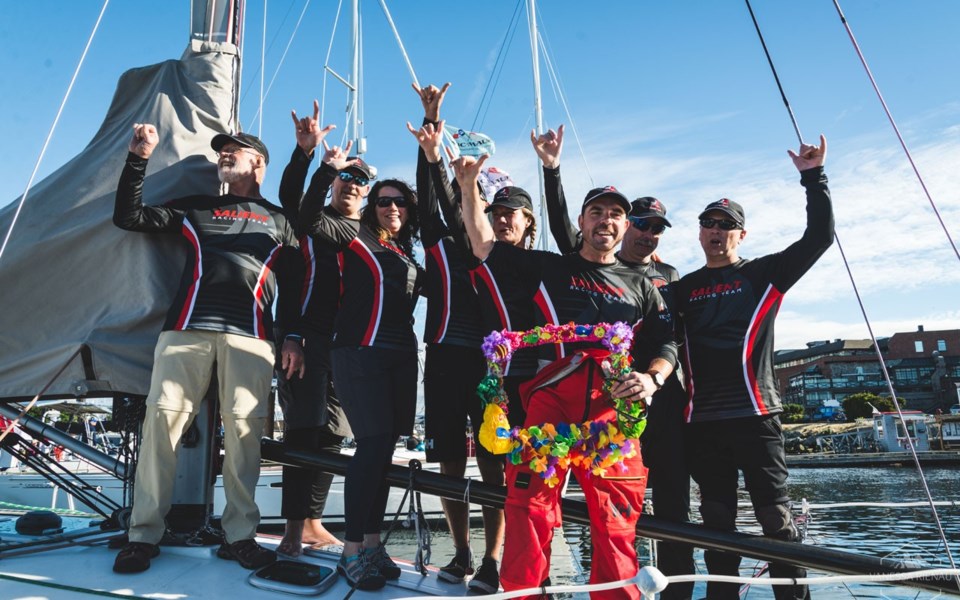The Salient Racing Team didn't make it easy on itself, but when it reached its Maui destination in first place in its division in the Victoria to Maui International Yacht Race, it was all worth it.
Whistler's Suze Cumming was part of the crew that left Victoria on July 1 and arrived in Hawaii two weeks later. She said the eight-person crew, skipped by Christof Marti, charted a longer, more difficult course that ultimately helped them win the Class 2 division.
"We took an unusual route," she said. "Normally, you're racing down the coast and then crossing the trade winds, but there were some weird weather patterns, so we went much higher than that. We had a really tough race. It was a lot of upwind sailing and we were separated from the fleet for most of the race.
"It ended up paying off in the end. It was harder sailing, but we ended up going fast."
Salient ended up needing all the advantage it earned, because as it approached Maui, so too did another pair of competitors.
"After 2,300 nautical miles, the top three boats in our division were within eight miles of each other," Cumming said. "We had visual contact with the second- and third-place boats when we finished, which is unheard of.
"It's super exciting, because it's 14 or 15 days, and we're all finishing within an hour, an hour and a half of each other. It was really tense those last couple of days because everybody was really close."
Though there was clear jubilation at the end, Cumming described the process as miserable, as the necessary choices for victory were demanding.
"Upwind sailing is typically more challenging physically, and it's more uncomfortable," she said. "The boat is heeled over, it's getting impacted by the waves and there are waves coming over the boat."
The crew divided each day into three four-hour shifts and two six-hour shifts, so it was difficult to sleep for more than a couple hours at a time. Cumming added that with a small team, she had a number of different responsibilities.
"Because there are four people on each watch, everybody does everything. Everybody steers, everybody trims, everybody cooks. We rotate through the various jobs," she said.
When out on the waters, racers aren't allowed to use any information to their advantage that isn't publicly available. However, if they can get a satellite phone to connect to the internet, they can check the tracker on the official race website or, in Salient's case, have a friend email them that data from the tracker.
"You're not allowed to get outside help, but that information, you're allowed to get," she said. "Twice a day, we got that file about where all our competitors were."
Cumming has sailed since she was a child, but took about 15 years off to raise her family. However, about two years ago, she decided to return and wanted to have a focus on ocean racing. She offered to help return one of the yachts from the race two years ago, gaining ocean experience and getting to know those onboard. Several of those sailors went on to form the team that she competed with this time around.
The crew handled the race's brutal conditions so well because the practice sessions were no picnic, either.
"We put a lot of work in over the last nine months," she said. "There were many, many weekends in the winter where there was wind and it was cold and nasty. Often, we'd train overnight so we'd be able to mimic the fatigue that we'd have. We'd train overnight with no sleep, and then we'd do all of our safety drills in the early, early morning when it was dark and we were still tired so we could work under stress."
As well, the team completed two long-distance regattas in order to help prepare.
Cumming also enjoyed sailing on the Beneteau First 40.7 yacht, but said there were some challenges competing on a vessel smaller than what other competitors raced.
"We put a ton of work into it. We made sure that every single aspect of that boat was in perfect condition—stress testing, rigging, really top to bottom we made sure the boat was 100 per cent," Cumming explained. "It's a small boat for a race of this size, so it was rough out there. A small boat gets thrown around more than a bigger boat would."




